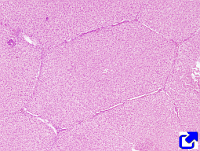Numerous substances involved in digestion are released into the digestive tract. Many of these substances are produced in glands found in the wall of the digestive tract, including the gastric glands of the stomach and the Lieberkühn crypts of the small intestine. However, there are two large glands associated with the digestive tract that are also involved in digestion: the liver and the pancreas. They are regarded as organs rather than just mere glands. Besides releasing essential components for food digestion, the liver and pancreas also perform other important functions for the body.

The liver develops from an invagination of the digestive tract wall during embryonic development. It is the largest viscera of the body and weighs about 1,500 g in humans. The liver performs numerous functions, such as the production of plasma proteins, maintaining a balance of glucose concentration, synthesizing and releasing vitamins and other nutritive substances into the blood, acting as a major detoxifying center, producing bile fluid, and releasing hormones as an endocrine gland. The liver is highly irrigated by arteries that come directly from the digestive tract, the spleen, and the pancreas.
Both endocrine and exocrine secretions of the liver are produced by hepatic cells, also known as hepatocytes. The hepatic exocrine secretion is the bile, which is collected in the hepatic canaliculi and carried toward the gallbladder, where it is stored. When required during digestion, bile is released from this temporary storage into the duodenum.
The pancreas is an elongated gland, much smaller than the liver, and situated at the level of the duodenum. It has two cellular components, or systems, that can be physiologically and structurally differentiated: one is endocrine, and the other is exocrine. The endocrine component releases hormones such as insulin and glucagon, both of which regulate metabolism. The exocrine component produces enzymes, which are released into the duodenum and are needed for digestion.
 Digestive system
Digestive system